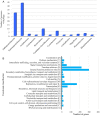Expanding our understanding of marine viral diversity through metagenomic analyses of biofilms
- PMID: 37073293
- PMCID: PMC10077207
- DOI: 10.1007/s42995-020-00078-4
Expanding our understanding of marine viral diversity through metagenomic analyses of biofilms
Abstract
Recent metagenomics surveys have provided insights into the marine virosphere. However, these surveys have focused solely on viruses in seawater, neglecting those associated with biofilms. By analyzing 1.75 terabases of biofilm metagenomic data, 3974 viral sequences were identified from eight locations around the world. Over 90% of these viral sequences were not found in previously reported datasets. Comparisons between biofilm and seawater metagenomes identified viruses that are endemic to the biofilm niche. Analysis of viral sequences integrated within biofilm-derived microbial genomes revealed potential functional genes for trimeric autotransporter adhesin and polysaccharide metabolism, which may contribute to biofilm formation by the bacterial hosts. However, more than 70% of the genes could not be annotated. These findings show marine biofilms to be a reservoir of novel viruses and have enhanced our understanding of natural virus-bacteria ecosystems.
Keywords: Biofilm; Metagenomics; Ocean; Virus.
© Ocean University of China 2021.
Conflict of interest statement
Conflict of interestThe authors declare that they have no conflict of interest.
Figures






Similar articles
-
Metagenomic Analysis of Zinc Surface-Associated Marine Biofilms.Microb Ecol. 2019 Feb;77(2):406-416. doi: 10.1007/s00248-018-01313-3. Epub 2019 Jan 5. Microb Ecol. 2019. PMID: 30612183
-
Marine biofilms constitute a bank of hidden microbial diversity and functional potential.Nat Commun. 2019 Jan 31;10(1):517. doi: 10.1038/s41467-019-08463-z. Nat Commun. 2019. PMID: 30705275 Free PMC article.
-
Microbial Diversity and Phage-Host Interactions in the Georgian Coastal Area of the Black Sea Revealed by Whole Genome Metagenomic Sequencing.Mar Drugs. 2020 Nov 14;18(11):558. doi: 10.3390/md18110558. Mar Drugs. 2020. PMID: 33202695 Free PMC article.
-
Metagenomic insights into taxonomic, functional diversity and inhibitors of microbial biofilms.Microbiol Res. 2022 Dec;265:127207. doi: 10.1016/j.micres.2022.127207. Epub 2022 Sep 21. Microbiol Res. 2022. PMID: 36194989 Review.
-
Computational approaches to predict bacteriophage-host relationships.FEMS Microbiol Rev. 2016 Mar;40(2):258-72. doi: 10.1093/femsre/fuv048. Epub 2015 Dec 9. FEMS Microbiol Rev. 2016. PMID: 26657537 Free PMC article. Review.
Cited by
-
Novel indole-mediated potassium ion import system confers a survival advantage to the Xanthomonadaceae family.ISME J. 2022 Jul;16(7):1717-1729. doi: 10.1038/s41396-022-01219-6. Epub 2022 Mar 22. ISME J. 2022. PMID: 35319020 Free PMC article.
-
Anaerobic thiosulfate oxidation by the Roseobacter group is prevalent in marine biofilms.Nat Commun. 2023 Apr 11;14(1):2033. doi: 10.1038/s41467-023-37759-4. Nat Commun. 2023. PMID: 37041201 Free PMC article.
-
Copiotrophy in a Marine-Biofilm-Derived Roseobacteraceae Bacterium Can Be Supported by Amino Acid Metabolism and Thiosulfate Oxidation.Int J Mol Sci. 2023 May 11;24(10):8617. doi: 10.3390/ijms24108617. Int J Mol Sci. 2023. PMID: 37239957 Free PMC article.
-
Exploring virus-host-environment interactions in a chemotrophic-based underground estuary.Environ Microbiome. 2024 Jan 30;19(1):9. doi: 10.1186/s40793-024-00549-6. Environ Microbiome. 2024. PMID: 38291480 Free PMC article.
-
The Landscape of Global Ocean Microbiome: From Bacterioplankton to Biofilms.Int J Mol Sci. 2023 Mar 30;24(7):6491. doi: 10.3390/ijms24076491. Int J Mol Sci. 2023. PMID: 37047466 Free PMC article. Review.
References
-
- Brum JR, Ignacio-Espinoza JC, Roux S, Doulcier G, Acinas SG, Alberti A, Chaffron S, Cruaud C, De Vargas C, Gasol JM, Gorsky G, Gregory AC, Guidi L, Hingamp P, Iudicone D, Not F, Ogata H, Pesant S, Poulos BT, Schwenck SM, et al. Patterns and ecological drivers of ocean viral communities. Science. 2015;348:1261498. doi: 10.1126/science.1261498. - DOI - PubMed
Associated data
LinkOut - more resources
Full Text Sources

